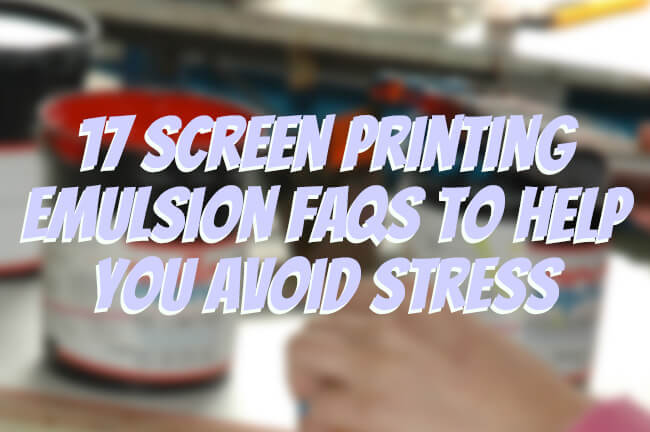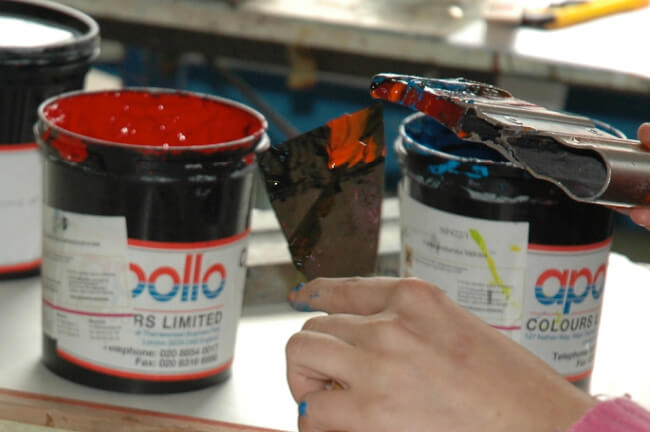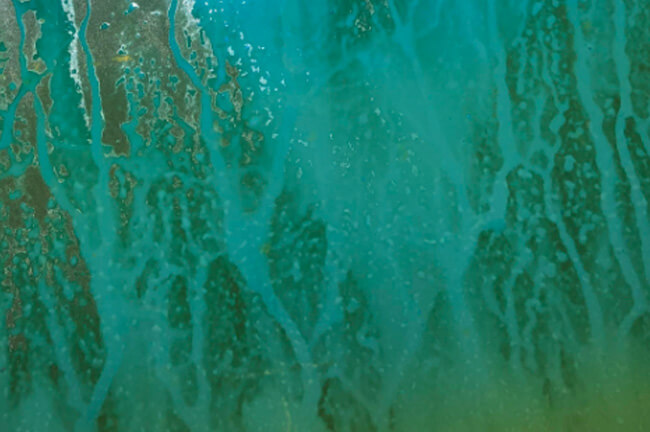
So you’ve gotten yourself a screen printing kit. You’re going through countless tutorials but you can’t seem to get past emulsion-related phases.
Whatever it is – coating frames, exposing films, or washing out stencils, your issue is unique and there isn’t a single Youtube video or forum post to help you become unstuck.
For many aspiring screen printers, creating the perfect stencil has always been the most hair-pulling, wall-punching, table-flipping part of the process.
So if you’re feeling tired, helpless, demotivated and wondering where you’ve gone wrong, don’t worry we’ve got your back!
I spoke to screen printing experts and got some words of wisdom to help beginners like you pull through these stressful times.
Here are some common screen printing emulsion FAQs will help you avoid messing up in the very near future.
Setup: Emulsion and screen preparation

1. I’m a beginner using water-based inks. What kind of screen printing emulsion should I buy?
You have two options.
The first is a photopolymer emulsion, and the second is a dual-cure emulsion.
Photopolymers are pre-sensitized and requires no mixing making it convenient as it’s ready to use straight out of the container. However, it is highly sensitive to UV light which means you have to make sure you’re in a darkroom with zero UV rays when it comes to handling this type of emulsion.
The next one is the dual-cure emulsion. This diazo emulsion does not come pre-sensitized which means a photo-sensitive additive must be added in order for it to expose your screens. Dual-cures can actually be exposed to UV light while wet without curing, and although not recommended, you can usually coat your screens under normal lighting.
For newcomers to the trade, I’d go with a photopolymer emulsion as they expose much quicker of the two emulsion types plus it also works well with a weak light source e.g. homemade exposure unit.
And if you’re using water-based inks, choose a photopolymer emulsion that’s specifically formulated for it since standard ones are mostly formulated for plastisol inks.
2. How many coats of emulsion should I have on each side of the screen?
Since there are many factors (ink type, emulsion type, mesh count, etc) that come into play, it’s up to you to find your balance. For starters, use these coating combos for your starting point:
- Test 1: 1/1 (1 coat print side/ 1 coat ink side)
- Test 2: 2/1 (1 coat print side, 1 coat ink side, 1 coat print side)
- Test 3: 2/2 (1 coat print side, 1 coat ink side, 1 coat print side, 1 coat ink side)
You should remember that nobody gets it right the first time. Not even the experts. Prepare yourself mentally so you don’t get too discouraged too quickly in the beginning.
3. Can I coat emulsion on only one side of the screen?
Unless you’re making a ton of prints (more than 100), you can get away with coating only one side (the ink side). As long as you’ve taken the proper screen prep – clean, de-haze, degrease, etc., and your exposure times are perfect, you should have no problems.
I also suggest using a smooth rounded edge scoop coater on these screens instead of the sharp edge.
4. How long should I let my coated screen dry?
Most manufacturers suggest a good 24 hours for a completely dried screen. But I know printers who wait only 30 minutes before moving on to exposure. They have the perfect setup for quick drying which are:
- Dehumidifier (skip if your environment is dry)
- Heat (not too much)
- Air flow
I personally keep two fans running in my darkroom at all times.
Just make sure your area is clean because sand, dust, hair follicles, and dirt can circulate in the air and get stuck on wet coated screens. This can cause blockages in the emulsion once it hardens.
5. Is a dark room necessary to coat my screens?
This goes back to the type of emulsion you’re using.
If you’ve opted for a photopolymer emulsion then the answer is YES! Again, photopolymer emulsion is super sensitive to ultraviolet (UV) rays, so unless you’re using a dual-cure emulsion, it’s best to work in a darkroom.
Many printers work in a room or basement with minimal to zero sunlight and use indoor, UV safe lighting such as a fluorescent lamp or a yellow bug light. Alternatively, you can coat your screens during the night if you don’t have such a space.
6. My emulsion-coated screen is already dried, is it safe to bring it out of the darkroom?
That depends.
Make sure it doesn’t come into contact with direct sunlight otherwise the exposure process will begin.
Regular fluorescent room lights are fine to work under. Just plan your move with a purpose and don’t leave your unexposed screen lying around in the light.
7. Must I use the screens right away once it’s coated with emulsion?
Emulsion coated screens can last up to a few weeks with proper storage conditions. This means keeping them in a dark room, dry and at room temperature.
However, you still need to adhere to manufacturer recommendations. Emulsions do not work the same and some may have limited shelf life. In general, try to use your coated screens within a week or two to avoid resistance from washing out the emulsion.
Execution: Burning and Exposing emulsion
8. I coated my screen. How long should I expose it in the Sun?
Depending on how strong the Sun is, anywhere from 25 seconds to a minute.
Wait until the Sun is at its peak (e.g. around noon) and its UV energy the highest. If it is overcast or cloudy it may take a few more minutes. If it’s your first time using the Sun as a light source, perform an exposure test to find the best time. I suggest coating 2-3 more additional screens for this.
9. What is the best method to expose a screen and for how long?
Although the Sun is the cheapest method, it’s not very reliable.
For consistency, get yourself an exposure unit. You can either buy one or build one yourself, but keep in mind that the quality of exposure also depends on the light source, emulsion type and distance.
To find the optimum time for exposure, follow the emulsion manufacturer’s recommendation. If this does not work, using a Stouffer’s 21 Step Transmission Scale test strip or this free exposure calculator will tell you exactly how long you need to expose your screens to light.
10. How do I know if my screen is underexposed?

Bad things happen to good people all the time. To know if your screens are underexposed, look out for these symptoms:
- Jagged edges – your image consists of irregular, unsharp edges. This means the emulsion has not been sufficiently hardened and has been washed away.
- Pinholes or rips – when you see transparent dots both tiny and large appear throughout your image, this means it’s been underexposed. Another obvious sign is having your emulsion rip away during washout.
- “Scum” – the image and the emulsion will wash out easily or you will have a thin layer of emulsion residue called “scum” still on the screen
- Total wash out – if your stencil becomes milky and washes out completely
To fix these problems, try increasing exposure time. Additionally, coat another layer of emulsion.
Read more: 3 Common Screen Printing Exposure Problems & 1 Simple Fix
11. How do I know if I over-exposed my screen?
Overexposure is way easier to identify.
If your image or any part of your image doesn’t rinse out properly, that means the emulsion has been exposed to too much UV and therefore has hardened. Dial down exposure time and keep on experimenting.
12. The emulsion is coming off while I’m printing, why?
First impression might suggest that the screen is underexposed, but it could also mean there is a mismatch in emulsion and ink.
If you’re using water-based ink, make sure you’re also using an emulsion designed for water-based ink. Similarly for plastisol.
If everything is good, then the next time you expose a screen and wash it out successfully, re-expose it again (Sun, halogen lamp, etc) to harden the screen before going to print. You can also spray the screen with an emulsion hardener to make it more resistant to water.
Storage: Overall maintenance

13. Where can I store emulsion coated screens?
All you need is a dark and dry place.
The best is a dark room. If you don’t have a spare room, then try and get creative. Suggestions I’ve heard are to use a cupboard, cardboard box, closet, dresser drawer or wrap it up with dark fabrics to avoid any exposure to UV light.
14. Can I prolong emulsion shelf life if I kept it refrigerated?
Some manufacturers tend to discourage refrigeration but many printers I know swear that it’s extended the emulsion’s lifespan.
I would say it’s conditional and would depend on the kind of emulsion you have and how you store it. There are many factors involved and refrigeration may damage more than help.
Personally, I found refrigeration adds a bit more time (about a month in my case), but I haven’t done it extensively because I usually end up finishing the tub.
I do find that it increases the viscosity making the emulsion harder to work with while coating. It’s like trying to spread butter when it’s cold. To fix it, I let the emulsion “thaw-out” the night before.
15. Can expired emulsion still be used?
There are significant shelf life differences between pure photopolymers and dual cure emulsions. The average lifespan for most pure photopolymers and dual cure emulsions are about a year from the date it was made, provided its stored well.
That said, I have a bucket of ProChem DCM that still works fine and it’s been more than a year past its expiration date. I keep it in a cool, dark place with no sunlight.
Diazo sensitized emulsions start to age when you mix the sensitizer with water. Manufacturers say you have a good 30 days of optimum performance.
Experienced printers say more, about 6-8 weeks if stored below 80 or 90 degrees, but that also depends on the brand. Another way is to refrigerate it to extend its time, but the emulsion mix needs to be stirred between days and make sure it doesn’t freeze.
16. My design has some fine details, which emulsion is right for me?
Go with an emulsion that is already pre-sensitized.
This type of emulsions are ready to use straight from the tub without any sensitizer, exposes faster and have a longer shelf-life. That said, they are very sensitive and you need to handle them carefully.
The slightest UV exposure could cause washout issues. short run water based jobs There are a few good brands from Prochem, Ulano and CCI.
Read more: 15 Screen Printing Mistakes You Can Avoid to Stay Motivated!
17. Is there a one-for-all type emulsion?
Sadly, no.
Every emulsion is formulated to suit a certain type of ink, so there is no one emulsion that can be used with plastisol and water based inks.
If you intend to print with various inks on a wide range of substrates, you’ll need more than one emulsion type in your storage room.
Wrap Up
Although I’ve tried to identify common screen printing emulsion problems in this article, the fact is, general help like this will only get you so far.
When it comes to actual troubleshooting, it’s always a good idea to go back and speak to the emulsion manufacturer. But even so, many factors influence the creation of the perfect stencil.
From coating thickness to mesh count, exposure lamp, UV light range to film opacity, the simplest way you’re going to get things right is to really, test things out yourself. Good luck!
